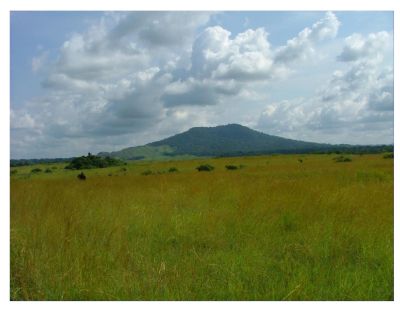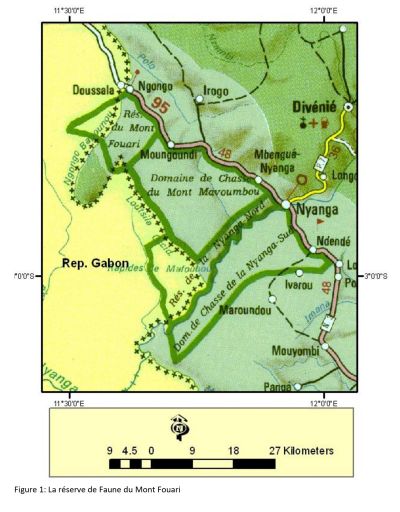Difference between revisions of "Mont Fouari"
(Created page with "<!-- INSTRUCTIONS FOR UPLOADING SITE INFORMATION - Wiki pages contain information in paragraphs, tables, lists, and images. - Text and images are not restricted, and their for...") |
|||
| (2 intermediate revisions by the same user not shown) | |||
| Line 23: | Line 23: | ||
[[File: Landscape Fouari.jpg | 400px | thumb| right | Landscape at Mont Fouari © Clement Inkamba Nkulu]] | [[File: Landscape Fouari.jpg | 400px | thumb| right | Landscape at Mont Fouari © Clement Inkamba Nkulu]] | ||
= Site characteristics = <!-- A paragraph summary of physical and geographic aspects of the site, and a table of key information --> | = Site characteristics = <!-- A paragraph summary of physical and geographic aspects of the site, and a table of key information --> | ||
| − | + | ||
The site is located in southwestern Republic of Congo, bordering Gabon, in the Department of Niari, Nyanga district. Wildlife species inhabiting the area include forest elephants (''Loxodonta cyclotis''), buffalos (''Syncerus caffer nanus''), sitatungas (''Tragelaphus spekei''), Defassa waterbuck (''Kobus ellipsiprymnus defassa''), Harnessed bushbucks (''Tragelaphus scriptus''), red river hogs (''Potamochoerus porcus''), six duiker species (''Cephalophus sp.''), wild cats and diurnal monkeys (e.g., ''Cercopithecus nictitans'', ''C. cephus'' and ''Miopithecus ogouensis'') (Inkamba Nkulu pers. comm. 2022). | The site is located in southwestern Republic of Congo, bordering Gabon, in the Department of Niari, Nyanga district. Wildlife species inhabiting the area include forest elephants (''Loxodonta cyclotis''), buffalos (''Syncerus caffer nanus''), sitatungas (''Tragelaphus spekei''), Defassa waterbuck (''Kobus ellipsiprymnus defassa''), Harnessed bushbucks (''Tragelaphus scriptus''), red river hogs (''Potamochoerus porcus''), six duiker species (''Cephalophus sp.''), wild cats and diurnal monkeys (e.g., ''Cercopithecus nictitans'', ''C. cephus'' and ''Miopithecus ogouensis'') (Inkamba Nkulu pers. comm. 2022). | ||
| Line 254: | Line 254: | ||
|} | |} | ||
[[Conservation activities list (Junker et al. 2017)]] | [[Conservation activities list (Junker et al. 2017)]] | ||
| − | + | [[File: Map Fouari.jpg | 400px | thumb| right | Map of Mont Fouari © Clement Inkamba Nkulu]] | |
= Challenges = <!-- Overview of challenges in ape conservation --> | = Challenges = <!-- Overview of challenges in ape conservation --> | ||
| Line 295: | Line 295: | ||
<br> | <br> | ||
| − | '''Page completed by: ''' | + | '''Page completed by: '''Clement Inkamba Nkulu, Principal investigator for WCS Bateke plateau''' Date:''' 04/04/2022 <!-- If you don't want to add your name, you can add "Clement Inkamba Nkulu" --> |
Latest revision as of 13:19, 4 April 2022
Central Africa > Republic of the Congo > Mont Fouari
Summary
- Central chimpanzees (Pan troglodytes troglodytes) are present in Mont Fouari.
- The population size is unknown.
- The chimpanzee population trend is unknown.
- The site has a total size of 156 km².
- Key threats to chimpanzees are hunting, logging, and agricultural expansion.
- Conservation activities have focused on raising awareness in local communities.
Site characteristics
The site is located in southwestern Republic of Congo, bordering Gabon, in the Department of Niari, Nyanga district. Wildlife species inhabiting the area include forest elephants (Loxodonta cyclotis), buffalos (Syncerus caffer nanus), sitatungas (Tragelaphus spekei), Defassa waterbuck (Kobus ellipsiprymnus defassa), Harnessed bushbucks (Tragelaphus scriptus), red river hogs (Potamochoerus porcus), six duiker species (Cephalophus sp.), wild cats and diurnal monkeys (e.g., Cercopithecus nictitans, C. cephus and Miopithecus ogouensis) (Inkamba Nkulu pers. comm. 2022).
Table 1. Basic site information for Mont Fouari
| Area | 156 km² |
| Coordinates | -2.765613, 11.686915 |
| Designation | Reserve |
| Habitat types | Subtropical/tropical moist lowland forest, savanna |
IUCN habitat categories Site designations
Ape status
Table 2. Ape population estimates in Mont Fouari
| Species | Year | Abundance estimate (95% CI) | Density estimate [ind./ km²] (95% CI) | Encounter rate (nests/km) | Area | Method | Source | Comments | A.P.E.S. database ID |
|---|---|---|---|---|---|---|---|---|---|
| Pan troglodytes troglodytes | 2005 | 0.07 | Mont Fouari | Index survey (reconnaissance walk) | WCS 2007 as cited by Inkamba Nkulu pers. comm. 2022 |
Threats
The main threats at the site include poaching for consumption and bushmeat trade, and destruction of habitat due to logging and agricultural expansion (Inkamba Nkulu pers. comm. 2022).
Table 3. Threats to apes in Mont Fouari
| Category | Specific threats | Threat level | Quantified severity | Description | Year of threat |
|---|---|---|---|---|---|
| 1. Residential & commercial development | Unknown | ||||
| 2. Agriculture & aquaculture | 2.1 Annual & perennial non-timber crops | Present, but threat severity unknown | Presence of agricultural fields (Inkamba Nkulu pers. comm. 2022). | Ongoing (2022) | |
| 3. Energy production & mining | Unknown | ||||
| 4. Transportation & service corridors | 4.1 Roads & railroads | Unknown | Presence of roads from Madanda to the west of the Mont Fouari reserve and from Dolisie to Ngongo village, which is the border of Gabon (Inkamba Nkulu pers. comm. 2022). | Ongoing (2022) | |
| 5. Biological resource use | 5.1 Hunting & collecting terrestrial animals | Present, but threat severity unknown | Poachers are hunting chimps in the area for bushmeat consumption and trade (Inkamba Nkulu pers. comm. 2022). | Ongoing (2022) | |
| 5.3 Logging & wood harvesting | Present, but threat severity unknown | Presence of a bulldozer destined for logging, from a Gabonese operator (Inkamba Nkulu pers. comm. 2022). | 2005 | ||
| 6. Human intrusion & disturbance | Unknown | ||||
| 7. Natural system modifications | Unknown | ||||
| 8. Invasive & other problematic species, genes, diseases | Unknown | ||||
| 9. Pollution | Unknown | ||||
| 10. Geological Events | Absent | ||||
| 11. Climate change & severe weather | Unknown | ||||
| 12. Other options | Absent |
Conservation activities
WCS and CNIAF organised an ecological survey in 2005 in several protected areas and protection zones in order to assess the conservation status of these sites (Inkamba Nkulu pers. comm. 2022).
Table 4. Conservation activities in Mont Fouari
| Category | Specific activity | Description | Year of activity |
|---|---|---|---|
| 1. Residential & commercial development | Not reported | ||
| 2. Agriculture & aquaculture | Not reported | ||
| 3. Energy production & mining | Not reported | ||
| 4. Transportation & service corridors | Not reported | ||
| 5. Biological resource use | 5.14. Inform hunters of the dangers (e.g., disease transmission) of wild primate meat | Community members are asked not to hunt and consume chimpanzees because primates in general may transmit Ebola (Inkamba Nkulu pers. comm. 2022). | Ongoing (2022) |
| 6. Human intrusion & disturbance | Not reported | ||
| 7. Natural system modifications | Not reported | ||
| 8. Invasive & other problematic species, genes, diseases | Not reported | ||
| 9. Pollution | Not reported | ||
| 10. Education & Awareness | 10.1. Educate local communities about primates and sustainable use | Communications to the public for the protection of primate habitats (Inkamba Nkulu pers. comm. 2022). | Ongoing (2022) |
| 11. Habitat Protection | 11.2. Legally protect primate habitat | The site is a protected area (Inkamba Nkulu pers. comm. 2022). | Ongoing (2022) |
| 12. Species Management | Not reported | ||
| 13. Livelihood; Economic & Other Incentives | Not reported |
Conservation activities list (Junker et al. 2017)
Challenges
Table 5. Challenges reported for Mont Fouari
| Challenge | Source |
|---|---|
| Lack of law enforcement | Inkamba Nkulu pers. comm. 2022 |
| Lack of human resources | Inkamba Nkulu pers. comm. 2022 |
| Lack of financial means | Inkamba Nkulu pers. comm. 2022 |
Research activities
The only known study at the site is the 2005 inventory conducted by WCS and CNIAF with the objective to investigate wildlife conservation status and human impact on the protected area in this region (Inkamba et al. 2007).
Documented behaviours
Table 6. Ape behaviors reported for Mont Fouari
| Behavior | Source |
|---|---|
| Not reported |
External links
References
Inkamba, N. C., Nganga, I., Diahouakou, R. et Moussoukou Mpemba, E. (2007). Sondage écologique des mammifères dans quelques aires protégées dans le district de Nyanga. Rapport WCS-CNIAF, 37p.
Page completed by: Clement Inkamba Nkulu, Principal investigator for WCS Bateke plateau Date: 04/04/2022

